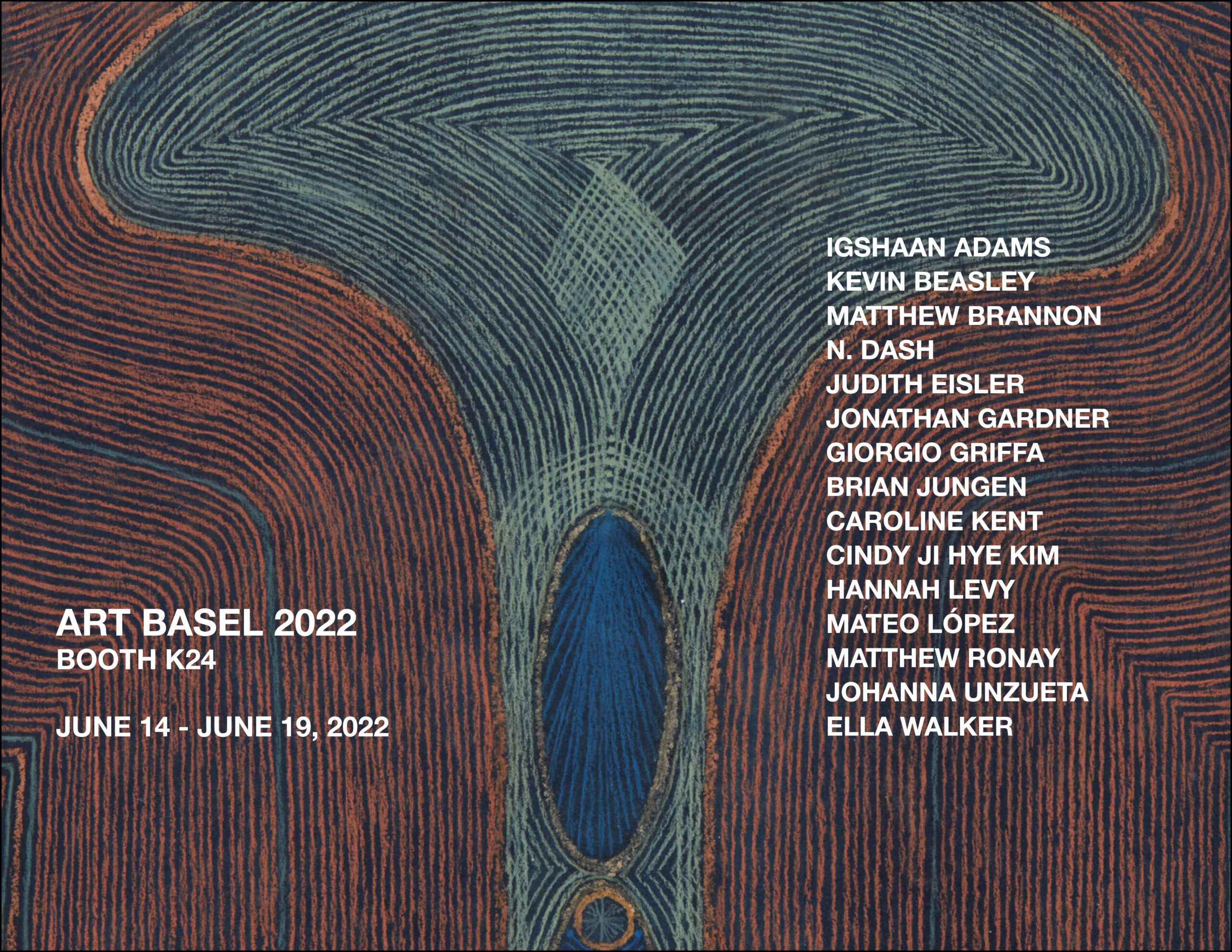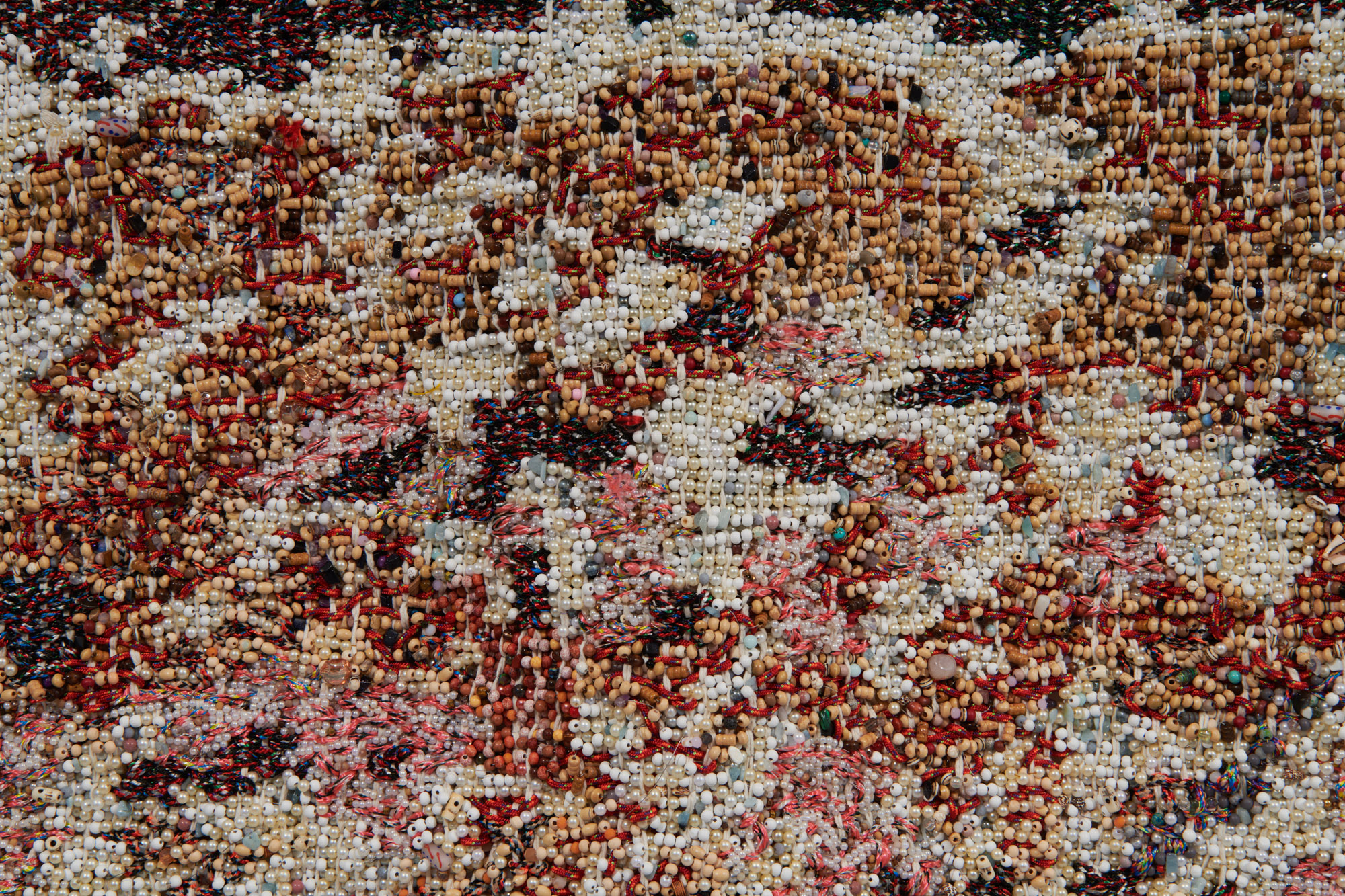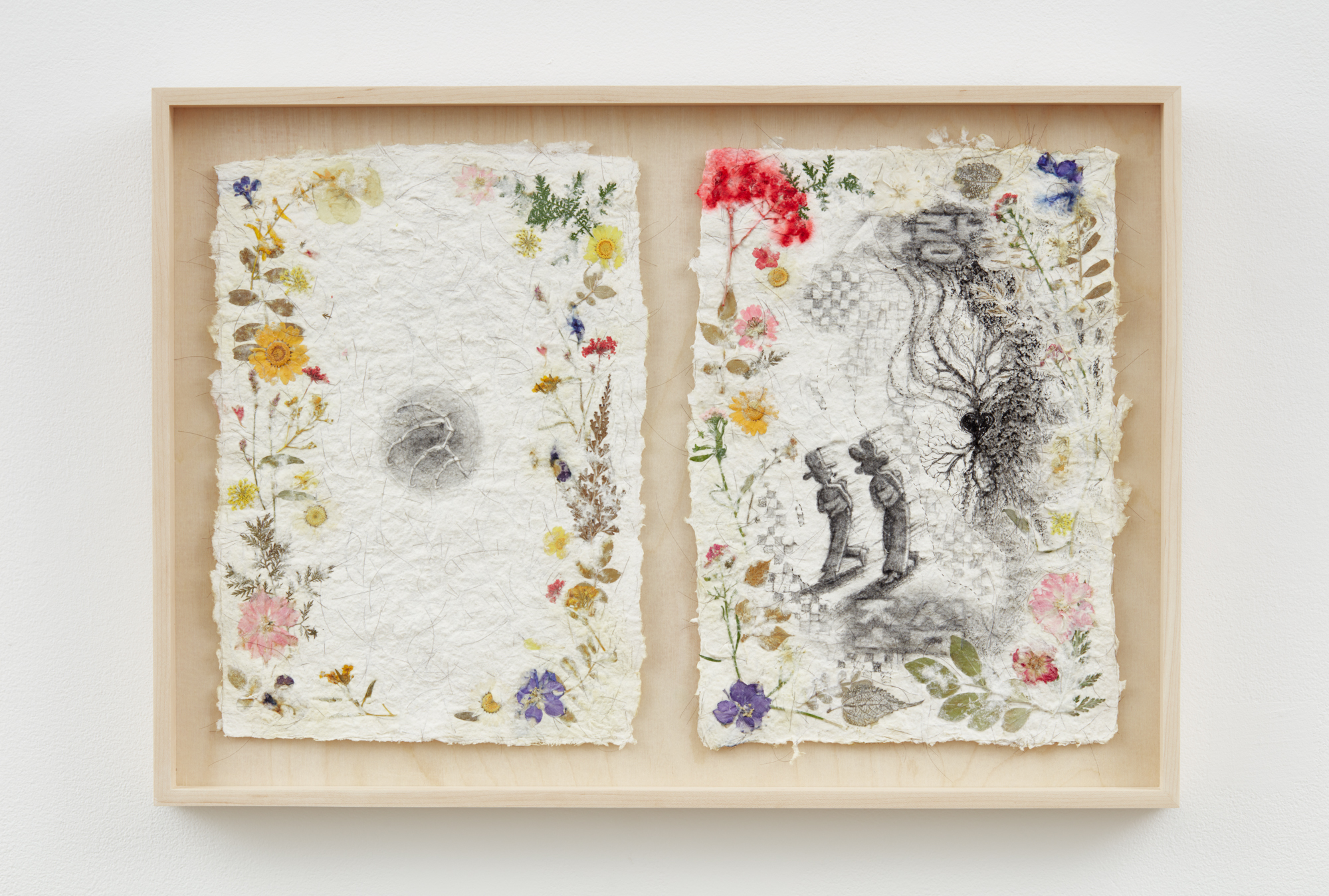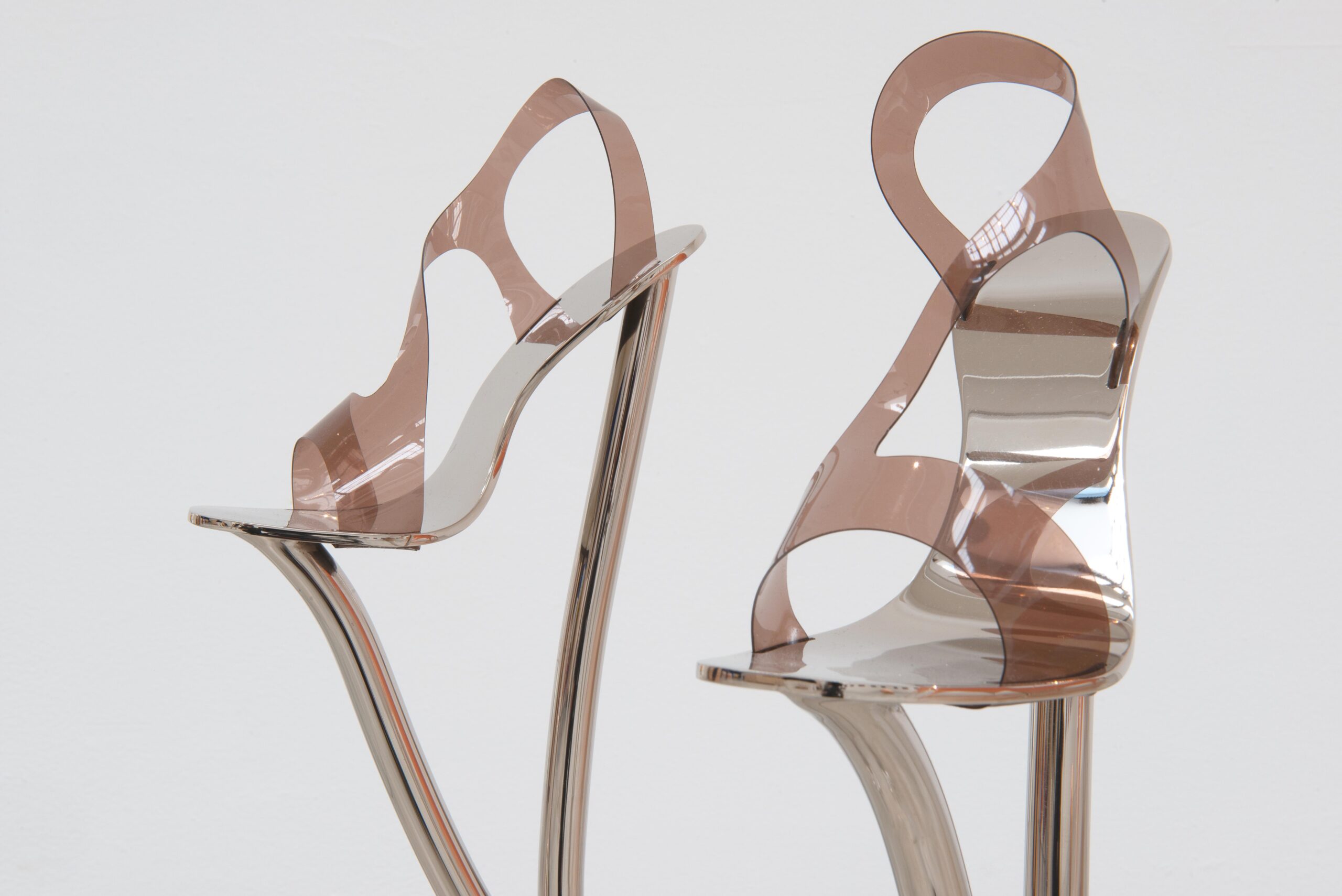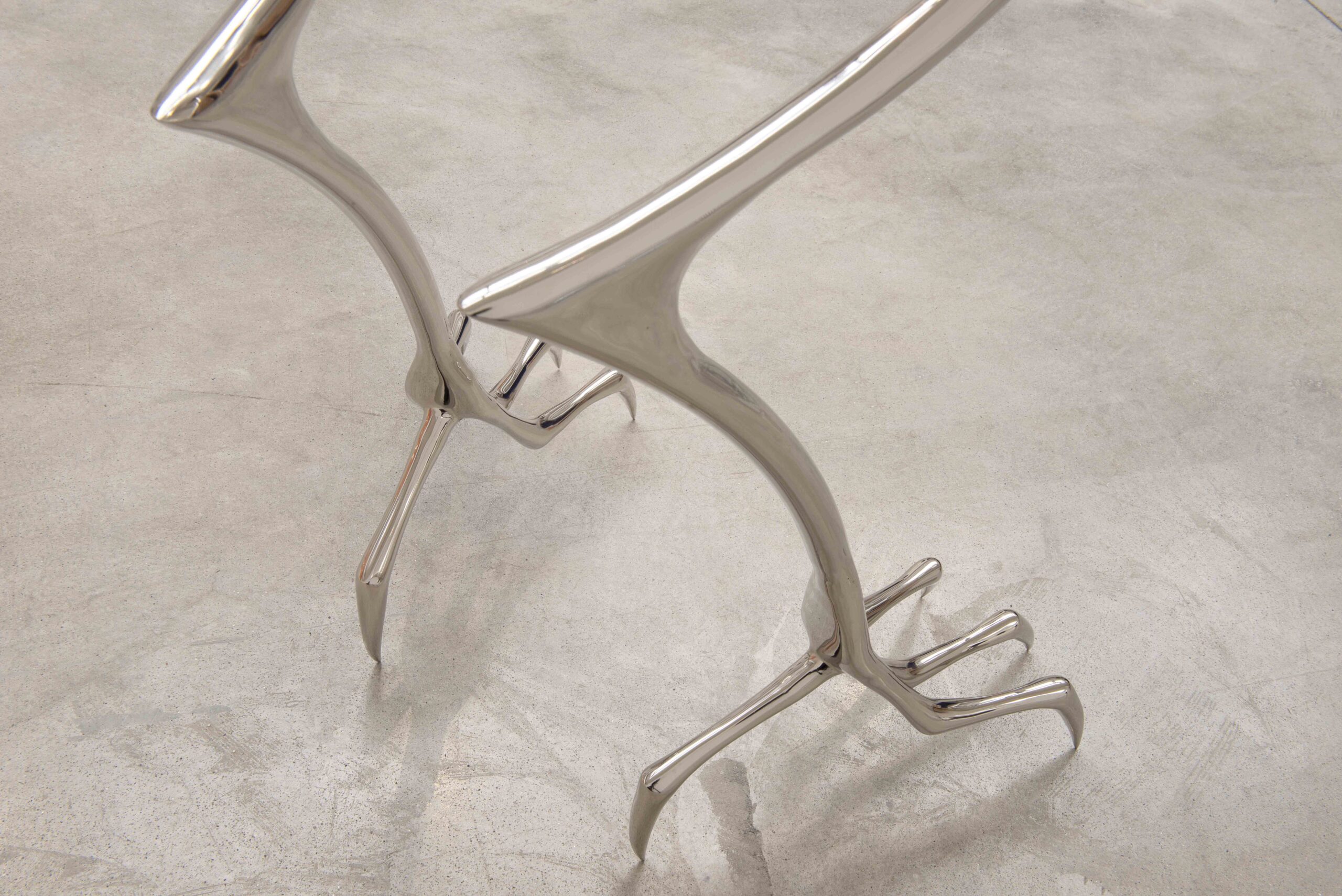![]()
Igshaan Adams
Hoek Onder Die Trappe (corner beneath the staircase), 2022
Wooden, acrylic painted beads, plastic, glass, stone, bone and shell beads, polyester and nylon rope, mix braided rope
93.7 x 118.11” / 238 x 300cm
IA2022-001
Igshaan Adams’ (b. 1982, Cape Town, South Africa) multi-disciplinary practice is an ongoing examination of hybrid identity, exploring notions of race, religion, and generational trauma. Adams combines weaving, performance, and installation in an intersection of personal history and his native Cape Town roots. Raised in Bonteheuwel, a former Cape Coloured township in Cape Town created during apartheid, the race-based legislation of the 1950s, Adams reshapes materials representative of his lineage—sourcing rope, cotton, beads, prayer rugs, garden fencing wire, and remnants of linoleum flooring found in the homes of working class, mixed-race, and black communities.
Hoek Onder Die Trappe (2022) (translated from Afrikaans to “corner beneath the staircase”) is part of Adams’ recent body of heavily embellished weavings inspired by patterns found in the remnants of linoleum flooring removed from the homes of childhood friends and neighbors, and then repurposed in the studio. Composed entirely of locally sourced materials purchased in Bonteheuwel — wood, plastic, stone, glass and bone beading, nylon rope, and cotton twine — the tapestries articulate actual spaces. Within Hoek Onder Die Trappe, Adams zooms in on two linoleum square tiles, revealing their decay over time. Relic-like, the extracted ground is a domestic time capsule recording bodily weight. Worn-out motifs reveal the daily movements of the people who live there, shedding history and trauma with each marking. Adams’ own history is housed in these spaces; memories from childhood through adolescence are imprinted upon these fragments that are transformed into handmade woven compositions.
![]()
Igshaan Adams, Hoek Onder Die Trappe (corner beneath the staircase), 2022 (Detail)
Adams is currently the subject of a solo exhibition at the Art Institute of Chicago (through August 1, 2022) and is included in The Milk of Dreams, 59th International Art Exhibition of La Biennale di Venezia, Italy, April 23 - November 27, 2022, curated by Cecilia Alemani.
![]()
Igshaan Adams, Hoek Onder Die Trappe (corner beneath the staircase), 2022 (Alternate View)
![]()
Kevin Beasley
Site X, 2022
Polyurethane resin, raw Virginia cotton, housedresses, t-shirts, confetti t-shirts, altered t-shirts, confetti housedresses
55.5 x 74 x 2” / 141 x 188 x 5.1 cm
KB2022-013
Kevin Beasley’s (b. 1985, Lynchburg, VA) series of “slabs" are comprised primarily of raw cotton harvested near his family’s century-old property in rural Virginia, as well as personal garments set in polyurethane resin. These sculptural forms revert back to antiquity, reflecting on ancient stone relief sculptures, specifically 9th c. BCE Assyrian reliefs which depict battle scenes, religious rituals, and courtly settings in rich detail and highly schematic imagery. Originally conceived in 2017, Beasley’s slabs began as large-scale square and rectangular structures that rested on the floor, flush to the wall with the potential to be rotated. In recent years, Beasley has elevated the slabs, which now hang on the wall, occupying the traditional space of painting.
Works from the artists’ recent "site" series, including Site X, are a further evolution of Beasley’s slabs. With transparent color fields of dyed resin, Beasley allows the viewer to see through the artwork. This interaction with the wall the work is hung from brings a new spacial element to Beasley’s established material formula of cotton, clothing, and resin. With the artist’s own body inscribed in each sculpture (as he can work with the resin for only as long as time allows before the polymer hardens), visual access to the inner workings of the slab urges a new consideration of the viewer’s physicality within the location and place the work is being viewed within.
Beasley’s work is currently on view in The Dirty South: Contemporary Art, Material Culture, and the Sonic Impulse at the Crystal Bridges Museum of American Art in Arkansas through July 25, 2022 as well as in The Worlds We Make: Selections from the ICA Collection at the Institute of Contemporary Art/Boston through December 2022.
![]()
Kevin Beasley, Site X, 2022 (Alternate View)
![]()
Kevin Beasley, Site X, 2022 (Detail)
![]()
Matthew Brannon
“Mouth-to-Mouth, Set & Setting” – Character Study. Set 02: Conceptual Art Curator, Soho, New York 1977, 2022
Silkscreen with hand painted details
52 x 67” / 132.08 x 170.18cm
Framed: 56.5 x 71.5” / 143.51 x 181.61cm
MB2022-001
Matthew Brannon’s (b. 1971, Anchorage, Alaska) distinctive visual language, developed through his unique prints, is imbued with wit and historical expertise. With traditional silkscreen printing techniques as well as hand-painting, the artist layers hundreds of screens in an intricate network of overlapping and boldly colored objects. Image and language intersect in evocations of dual meanings and underlying narrative.
In recent years, Brannon has focused almost exclusively on the time period of the Vietnam/American War as a source of inspiration—conducting exhaustive research with this generation-defining trauma. Often focusing on interior scenes that depict, from a first-person perspective, the desks of past presidents or the vanities of first ladies, which make use of subtle environmental clues found in personally significant possessions, Brannon creates visual narratives that speak to the life and psyche of his implied or defined subjects.
For Art Basel 2022, Brannon presents, “Mouth-to-Mouth, Set & Setting” – Character Study. Set 02: Conceptual Art Curator, Soho, New York 1977 (2022), a silkscreen with hand painted elements depicting the living room of an unnamed character from a hypothetical neo-noir romance film written by the artist, titled “Mouth-to-Mouth, Set & Setting”. In Brannon’s words, “I wanted to make films. But I also understood the film endeavor to be a tedious minefield of personalities and expense. And then I thought, what if I did everything that interests me about film, without the complexity required of producing the actual film?”
The character in “Mouth-to-Mouth, Set & Setting” – Character Study. Set 02: Conceptual Art Curator, Soho, New York 1977 (2022) works as a conceptual art curator at the time of her silkscreen personification. As in Brannon’s other ‘desk-based’ works, the artist includes objects the subject would have used and interacted with as a means of signifying their identity. A backgammon set, pieces remaining on the board after a game, as well as a phone, receiver dangling, set a backdrop for the character’s lifestyle and hint at the presence of another character. Cultural artifacts situate the subject in time and define her interests: a record, “Two Sevens Clash”, the debut album of roots reggae band Culture, peeks out under a ticket stub for “The American Friend”—a 1977 neo-noir thriller involving an art forgery scheme and murder for hire.
![]()
Matthew Brannon, “Mouth-to-Mouth, Set & Setting” – Character Study. Set 02: Conceptual Art Curator, Soho, New York 1977, 2022 (Alternate View)
![]()
N. Dash
Untitled, 2022
Earth, acrylic, canvas, oil, silkscreen ink, jute
79” x 51”/ 200.66 x 129.54 cm
ND2022-001
![]()
N. Dash, Untitled, 2022 (Detail)
N. Dash’s (b. 1980, Miami, FL) practice visually indexes the labor of human touch through a durational and corporeal engagement with material as a physical response to spatial architecture and the erosion of the environment within the industrialized world. Elements of earth, paint, string, strips of Styrofoam, plastic bottles and cast-off cardboard are assembled in pursuit of a textural resonance that marks a tension between industrially produced goods and naturally occurring substances.
For Art Basel 2022, N. Dash presents a new multi-panel composition that draws from the languages and methods of painting, sculpture, photography, and printmaking. A preoccupation with undoing and remaking is evidenced by the artist’s creation of minuscule fabric sculptures. Working small pieces of machine-loomed fabric between fingers and thumb for long durations until the gridded threads collapse into suggestive, disorderly tangles, N. Dash literally unfastens a structured industrial product in order to create a new form that magnifies the power of touch and ritual. Here, a fabric sculpture has been photographed and then silkscreened as a vastly enlarged version of itself. Image fuses with oil paint to reflect a further dimensionality, exposing the artist’s hand through steady yet gestural brushwork.
A narrow, three-dimensional panel composed of earth is painted, and bisects the underlying image. Desert ground, a staple within Dash’s practice, is applied in smooth, graded layers that crack and fissure during the drying process, creating a topological field. This architectural element exists as an earth core of the composition’s whole, bridging intimate touch with the boundlessness of the natural world.
N. Dash lives and works in New York and New Mexico. Dash is slated to present her first solo museum exhibition in Europe at Stedelijk Museum voor Actuele Kunst (S.M.A.K.), June 25 - November 6, 2022.
![]()
N. Dash, Untitled, 2022 (Detail)
![]()
N. Dash, Untitled, 2022 (Alternate View)
![]()
N. Dash, Untitled, 2022 (Detail)
![]()
Judith Eisler
Glint, 2012-22
Oil on canvas
47.24 x 59.1” / 120 x 150cm
JE2012-001
![]()
Judith Eisler Glint, 2012-22 (Detail)
Judith Eisler (b. 1962, Newark, NJ) explores psychological tension and technologically mediated imagery through digitally altered portraits of cinematic heroines. Following a series of interventions, the artist translates film stills onto paintings, mobilizing form and color to develop work that captures mental, digital, and physical transformations. The Pictures Generation (1974 - 1984) explored the deconstructed nature of a popular image as their point of departure. Artists such as Dara Birnbaum, Sarah Charlesworth, and Jack Goldstein utilize fragmentation, repetition and recontextualization to render body, object and perception as urgent and technically fraught. While this movement universally appropriated popular media, Eisler approaches her subject matter through an internal contemplation of female icons relevant to her own experience.
Glint (2012-22) depicts German-French actress Romy Schneider with her eyes cast downward. The image is lifted from a documentary about the actress “Romy: Anatomy of a Face” (1967), directed by Hans-Jürgen Syberberg. The documentary radiates a closeness and vulnerability between Schneider and Syberberg; the actress discusses her career to date in a soft, modulating voice against music from the 1960s, including Oscar Peterson’s “Tangerine” and “Bee-Bom” by Sammy Davis Jr. Schneider began her acting career at the age of 15 in 1953 and is known in part for her multiple portrayals of Empress Elisabeth of Austria—first in the trilogy “Sisi” by Ernst Marischka (1955-57) and later in in Luchino Visconti’s “Ludwig” (1973). The artist’s use of form, color, and line in this work reveals her compulsion towards the language and history of painting.
Eisler’s second solo exhibition with Casey Kaplan, Strange Weather Summer, is on view at the gallery through July 29, 2022.
![]()
Judith Eisler, Glint, 2012-22 (Alternate View)
![]()
Jonathan Gardner
Burning Sage, 2022
Oil on linen
62 x 42” / 157.5 x 106.7cm
JG2022-001
Jonathan Gardner (b. 1982, Lexington, KY) conjures invented universes. His compositions recall figures and objects familiar yet obscure, anchored by 20th century art historical references and imagery. Nameless subjects are situated in narrative scenes with flattened compositions and fantastical scales that thread mystery and wonder. With various stylistic influences, Gardner’s paintings merge geometric structure with surrealism. The illusionary worlds of Jim Nutt, Balthus, Léger, Picasso and Matisse are present, timeless, and manipulated by Gardner’s formulaic techniques reminiscent of tromp l’oeil.
![]()
Jonathan Gardner, Burning Sage, 2022 (Detail)
In Burning Sage, the central character’s attire echoes 1930’s fashion and the photographic subjects of Cecil Beaton. Smoke, renderend fantastically, spirals from a bundle of the dried herb. Its undulating shape is parroted throughout the canvas—in the formation of the grand-vase, along the grassy mountain of the imagined painting, and throughout the wood-floor detailing. These oscillations exist in a rythmic contrast to the sharp lines of the work’s blue tile and the square patterning of the subject’s collar. The result is a painting inflused with deliberate and referential dynamism.
![]()
Jonathan Gardner, Burning Sage, 2022 (Detail)
![]()
Jonathan Gardner, Burning Sage, 2022 (Alternate View)
![]()
Giorgio Griffa
Da sinistra, 1969
Acrylic on canvas
48 x 37.4” / 122 x 95cm
GG1969-011
For over fifty years, Giorgio Griffa (b. 1936, Turin, Italy) has developed a painting practice that records “the memory of material,” a process the artist believes is “constant, and never finished,” allowing brush, paint, and canvas to dictate the outcome of his work. Since the late 1960s, the “intelligence of painting” has been paramount to Griffa’s practice. Through the pictorial language he creates, the artist succumbs fully to the materials at his disposal rather than being driven by an analytical approach based on representation. Eliminating narrative and perspective, Griffa approaches painting like a meditation of sorts—reducing his markings to a repetitive sequence of lines, gestures, and symbols dictated by the materials themselves and revealing nothing other than an action recording time within space.
For Art Basel 2022, Casey Kaplan presents Da sinistra (1969), one of a finite number of works produced in Griffa’s first two years of working within his specific visual vocabulary. Starting with unprimed, unstretched raw canvas laid out like sheets on the studio floor, Griffa works slowly across them, crouching and kneeling on the material in a way that aligns him with his tools as the canvas becomes the ground for water-based acrylic paints, mixed thinly, to seep and bleed upon application. Random groupings of rose-colored diagonal brushstrokes line the left margin of Da sinistra, leaving the majority of the canvas blank. The rawness of the resulting composition gives Griffa’s paintings a provisional feel, emphasizing his convictions about the independent life of materials. The paintings are then displayed unframed, pinned to the wall with small nails along their top edge, and when not exhibited, are folded and stacked by year, creating an underlying grid for his compositions.
Griffa is currently the subject of a solo exhibition at the Centre Pompidou, Paris, France, on view through June 27, 2022.
![]()
Giorgio Griffa Da sinistra, 1969 (Detail)
![]()
Brian Jungen
Americas Most Wanted #1, 2016 (Detail)
Nike Air Jordan soles
9.75 x 10.25 x 17.25” / 24.8 x 26 x 43.8cm
BJ2016-012
Brian Jungen’s (b. 1970, Fort St. John, BC, Canada) employs the artistic vernacular of First Nation objects in an exploration of contemporary consumerism and its links to indigenous heritages. Central to the artist’s work is an inherent tension between material and form—Jungen leverages modern athletic-oriented products and reconstructs them into totemic states. Americas Most Wanted #1 (2016) reveals a commitment not only to dismemberment and rebuilding, but also to marking passages of time. The work was created more than twenty years after Nike’s release of the first Air Jordan in 1985 and is comprised of rubber soles bolted together into a wall-bound relief. The exposed layers of this cube-like piece reveal evolutions of design through decades, deepening an understanding of commodity culture. When first launched, Air Jordan’s were particularly inaccessible to Jungen’s Doig River communities. As they have become increasingly present globally, the artist considers the rippling effects on heritage and consumerism.
![]()
Brian Jungen, Americas Most Wanted #1, 2016 (Alternate View)
![]()
Brian Jungen, Americas Most Wanted #1, 2016 (Detail)
![]()
Caroline Kent
The courage to venture to the edge of reason, 2022
Acrylic on unstretched canvas
104.5 x 83” / 265.43 x 210.82cm
CK2022-006
Caroline Kent (b. 1975, Sterling, IL) engages in a visual language of abstraction through an instinctive approach to color and form. Her multidisciplinary practice encourages a mutual exchange between maker and viewer by way of invented modes of communication. Through painting, drawing, sculpture, text, and performance, Kent stretches the limitations of language to create a meaningful space for both silence and sound, shape, and empty ground.
For Art Basel 2022, the artist presents a new monumental painting on unstretched canvas: The courage to venture to the edge of reason (2022). The work is primarily monochrome, with each form generating a varying shade of blue. Shadowed shapes pass through veiled layers of black ground, never reaching the surface. These unknown depths and a reduction in color confront notions of illegibility, proclaiming multiple, indeterminate meanings that challenge the viewer to actively read the image. Akin to scenography in a one-act play, the composition is characterized by the tensions and tumult of stories that build towards a single, climactic ending.
A site-specific mural is currently on view at BAMPFA, Berkeley, CA, through October 30, 2022. The artist’s solo exhibition at the MCA Chicago closes on June 12th.
![]()
Caroline Kent, The courage to venture to the edge of reason, 2022 (Alternate View)
![]()
Caroline Kent, The courage to venture to the edge of reason, 2022 (Detail)
![]()
Cindy Ji Hye Kim
Asinus III: Exit I, Outcry, 2022
Graphite and ink on pulp, pressed flowers, artist’s hair, baltic birch
99.5 x 24 x 32” / 252.7 x 60.96 x 81.28cm
CHK2022-014
Cindy Ji Hye Kim (b. 1990, Incheon, Korea) creates work that bleeds together painting and sculpture, drawing and installation. Rooted in a fascination with mnemonic evolutions, the artist’s practice is motived by a poetic tension between what is remembered and forgotten, real and imagined. In recounting a dream, for instance, there may be intentions to accurately relay what transpired, however memory’s deceitful edge may render this challenging. For the artist, keeping the past in living memory requires confabulating: casting light on what is essentially obscure.
Asinus III: Exit I, Outcry is composed of a custom easel and two hand- made pulp paper drawings. The paper is embedded with pressed flowers and the artist’s own hair which Kim describes as an attempt to breathe life into the work. The right graphite drawing includes two characters that reappear throughout Kim’s work. These protagonists are flanked by checkerboard patterns, Hangul characters, and a shadow figure in a dreamlike amalgamation of memory and childlike fear. The left drawing is minimal by comparison—a skeletal structure of a wing rests in the center of the page, allowing the eye to linger on the textural intricacies that surround it. In presenting the drawings together, Kim emphasizes underlying themes of duality central to her practice—the forgotten and the recalled.
Kim’s first solo exhibition with Casey Kaplan closed in April 2022. In October 2022, a solo exhibition will open at Kunsthall Stavanger, Stavanger, Norway and her work will be in included the Frye Art Museum’s upcoming exhibition Door to the Atmosphere.
![]()
Cindy Ji Hye Kim, Asinus III: Exit I, Outcry, 2022 (Detail)
![]()
Cindy Ji Hye Kim, Asinus III: Exit I, Outcry, 2022 (Detail)
![]()
Hannah Levy
Untitled, 2022
Nickel-plated steel, PVC
29.75 x 16.25 x 5” / 75.6 x 41.3 x 12.7cm each
HL2022-002
A pair of PVC sandals are extended by spindly, steel appendages that end in honed hand carved steel talons. To render the clawed stilts and much of the metalwork throughout her oeuvre, Hannah Levy (b. 1991, New York, NY) carves welded steel rods in her studio, rather than using the usual methods of foundry casting. Seemingly and intimidatingly wearable, the exaggerated high heeled sandal is playfully precarious. They serve as a visual proposition of a kind of dangerous and skittering walk and overall impossibility of movement in spite of the fact that they can, technically, be worn.
Levy is interested in the visual equivalent of “carbon dating” objects by their adherence to trends. Her work often blends design references from several different contexts. Untitled, 2022 —a work she terms as stilts—pays homage to a historical Art Nouveau stool designed by Hector Guimard. She combines this historical reference with contemporary fashion tropes, the transparent straps and a square toe place the shoes’ design firmly in the now.
Levy is currently included in The Milk of Dreams, 59th International Art Exhibition of La Biennale di Venezia, Italy, April 23 - November 27, 2022, curated by Cecilia Alemani, as well as 52 Artists: A Feminist Milestone at the Aldrich Contemporary Art Museum in Ridgefield, CT, on view through January 2023.
The artist is slated to present solo exhibitions at the Berkeley Art Museum and Pacific Film Archive (BAMPFA) in California, opening August 2022, and Casey Kaplan, New York in March of 2023.
![]()
Hannah Levy, Untitled, 2022 (Detail)
![]()
Hannah Levy, Untitled, 2022 (Detail)
![]()
Mateo López
Red Line (Linea roja), 2020
Bronze cast, patina, red thread
Bronze cast: 0.75 x 2 x 2.5” / 1.9 x 5.1 x 6.4cm each
Installation equivalent to the artist’s height and wingspan
Corner installation: 62 x 65 x 31” / 157.5 x 165.1 x 78.7cm
Linear installation: 62 x 65 x 2.5” / 157.5 x 165.1 x 6.4cm
Edition 1 of 3, 1 AP
ML2020-015.1
![]()
Mateo López, Red Line (Linea roja), 2020 (Detail)
Mateo López (b. 1978, Bogotá, Colombia) expands the scope of drawing to consider the medium in time and space, ultimately pushing the boundaries of the page, and our perception of environment. His multifaceted practice spans diverse fields of study, from architecture and design to educational theory and dance, which takes form in works on paper, sculpture, site- specific installation, and performance. Red Line (Linea roja), (2020) is in dialogue with a series of bronze works cast from the artist’s own body. In this case, López’s left and right forefinger and thumb are rendered, each holding one rend of a red thread. This thread creates a taught line in space, echoing mark-making in space. Further the bronze’s patina is reminiscent of graphite, a tool often utilized in ideation and exploration. In effect, the line has walked off the page and into three-dimensional space.
Círculo de Palabras, López’s third solo exhibition with Casey Kaplan closed in April 2022.
Matthew Ronay’s (b. 1976, Louisville, KY) practice is the embodiment of a masterful handling of materials through a fetishistic pursuit of form. Working primarily with basswood, his sculptures are all made by hand; each component carved, whittled, sanded, pierced, dyed, and jointed together into colorful configurations that visually defy their wooden medium and conjure traditions of non-western art making and American folk art.
A Herald in Scarlet (2022), is comprised of teal tubular elements of textured wood, weaving in and out from one another in an imagined system. An organic scarlet form, positioned horizontally, orients the viewer to the front of the object, always visible as a result of the sculpture's open framework.
Ronay will present a solo exhibition at the Nasher Sculpture Center in Dallas, TX, opening September 2022.
![]()
Matthew Ronay
A Herald in Scarlet, 2022
Basswood, dye, gouache, steel
22.25 x 17.75 x 12” / 56.5 x 45.1 x 30.5cm
MR2022-002
![]()
Matthew Ronay, A Herald in Scarlet, 2022 (Detail)
![]()
Johanna Unzueta
March, April 2021 Berlin, 2022
Watercolor, pastel pencil, oil sticks, needle holes, and cut paper on tinted watercolor paper (Indigo/añil, wild berry/ Schneebeere), plexiglass, wood, bronze screws
Drawing: 43 x 43” / 109.22 x 109.22 cm
Installation dimensions: 60 x 47 x 9.84” / 152.4 x 119.39 x 25 cm
JU2022-001
Johanna Unzueta’s (b. 1974, Santiago, CL) interdisciplinary practice pays homage to her Chilean upbringing through an engagement in the surrounding communities, landscape, and histories of Latin America. Unzueta’s drawing practice is an intimate one that channels her intuitive expression. Each drawing is situated and titled within its place and time of creation, ultimately serving as a kind of cartography of place. The drawings’ patterns, created from paper templates and embroidery hoops, mimic the textile language of Unzueta’s weaving practice and suggests a close relationship between her drawings and sculpture. In their immediacy, they maintain an honest connection to the self and to the practice of automatic making, like the surrealists.
For Art Basel 2022, Unzueta presents March, April 2021 Berlin (2022), a geometric drawing dominated by a burnt umber circular composition against a navy background, earmarked by four cut out forms that mimic the shape of maple tree seeds. The various colors are made with indigo dye, watercolor, and pastel, highlighting Unzueta’s use of natural pigments. The rich-hued blue dye from the Guatemalan indigo plant is a staple in her works on paper, a material learned and cultivated from her apprenticeship with indigenous Mapuche women in rural Chile. Upon completion of the drawing, the paper is punctured with needle holes that allow for light to penetrate, essentially creating a conduit for space.
Unzueta gives her drawings three-dimensional form through their installation between sheets of Plexiglas on a wood base, a method of display reminiscent of Italian- Brazilian modernist architect Lina Bo Bardi. In this way, the work relates to the human body and allows the viewer to encounter the drawing more intimately and from both sides. As Unzueta explains, “One day, I drew a circle that was me and a bigger circle that was society, like a mathematical subset. I saw that where they overlap is what we create.”
Unzueta’s first solo exhibition at Casey Kaplan is scheduled for January 2024.
![]()
Johanna Unzueta, March, April 2021 Berlin, 2022 (Alternate View)
![]()
Johanna Unzueta, March, April 2021 Berlin, 2022 (Alternate View)
![]()
Johanna Unzueta, March, April 2021 Berlin, 2022 (Detail)
![]()
Ella Walker
Cutting flowers, 2022
Acrylic dispersion, pigment, chalk, and pencil on linen
82.68 x 39.37 x 7.87” / 210 x 100 x 20cm
EW2022-015
Within the intersection of medieval and contemporary spaces, Ella Walker (b. 1993, Manchester, UK) moves freely, interchanging histories with invented scenes that are both referential and dream-like. Combining painting, drawing, and fresco - incorporating a vast array of mediums including, tempura, gesso, pastel, and ink - Walker creates shallow, stage-like, depths of field, interspersing flat planes of color that disturb her viewer’s holistic sense of structure and composition. Walker translates ritual into innovation by creating imagery that merges art historical iconography from the Trecento period, theatrical sets and stock characters from Commedia dell’Arte, contemporary ballet, and costume design. The resulting meeting challenges viewers’ understanding of the sacred and profane, while simultaneously encourages the rethinking of binaries of old and new, high and low culture.
Walker’s latest body of work materializes within the framework of Giotto’s 1305 allegorical fresco mural at the Scrovegni Chapel in Padua, Italy. As each panel in the sequence describes Giotto’s personified scenes of virtue and vice, Walker positions herself at the fulcrum, refitting old narratives into contemporary plots of unfolding tragedy, comedy, and love. For Basel 2022, the artist presents Cutting Flowers (2022), an unstretched painting, hanging loose from a wooden armature like a backdrop on an imagined stage. The work is based on the Scrovegni panel containing Giotto’s personification of the virtue “Hope.” A direct representation of Giotto’s characterization centers the work, with a troupe of characters flanking the virtuous figure in a shallow field. Walker’s imagined narrative of “hope” plays out in unexpected ways, including cut violet blooms flowing through a hole in the left figure’s chest, her gaze meeting the viewer’s. A hand reaches into the scene, hovering over a disjoined head cradled within a marigold and scarlet net, while extending another cut flower. A third figure, garbed in the boning of a hoop skirt, supplies scissors.
Ella Walker’s first solo exhibition Theatre of Virtues and Vices at Casey Kaplan is currently on view until July 29.
![]()
Ella Walker, Cutting flowers, 2022 (Detail)
![]()
Ella Walker, Cutting flowers, 2022 (Alternate View)
